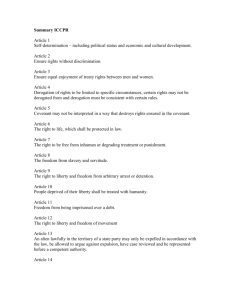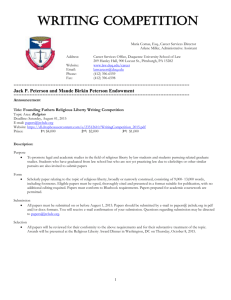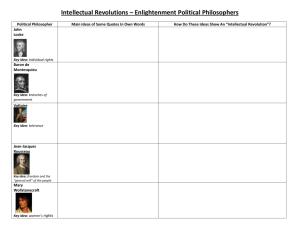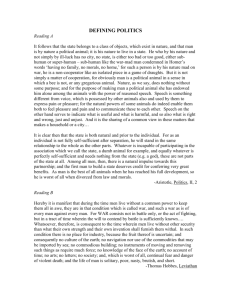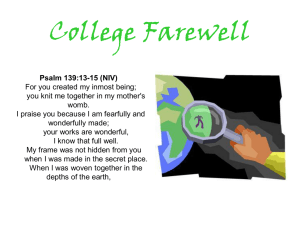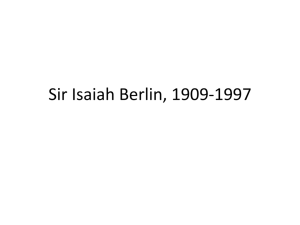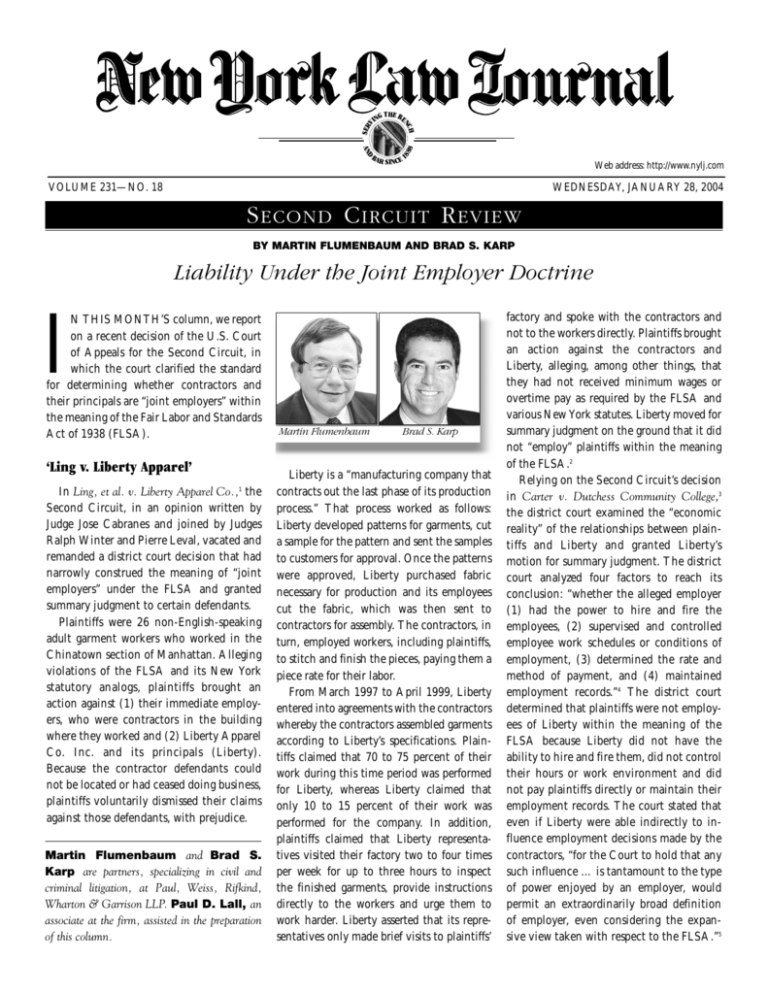
AND
88
8
SER
V
H
NC
THE BE
ING
BA
R SINCE 1
Web address: http://www.nylj.com
VOLUME 231—NO. 18
WEDNESDAY, JANUARY 28, 2004
S ECOND C IRCUIT R EVIEW
BY MARTIN FLUMENBAUM AND BRAD S. KARP
Liability Under the Joint Employer Doctrine
I
N THIS MONTH’S column, we report
on a recent decision of the U.S. Court
of Appeals for the Second Circuit, in
which the court clarified the standard
for determining whether contractors and
their principals are “joint employers” within
the meaning of the Fair Labor and Standards
Act of 1938 (FLSA).
‘Ling v. Liberty Apparel’
In Ling, et al. v. Liberty Apparel Co.,1 the
Second Circuit, in an opinion written by
Judge Jose Cabranes and joined by Judges
Ralph Winter and Pierre Leval, vacated and
remanded a district court decision that had
narrowly construed the meaning of “joint
employers” under the FLSA and granted
summary judgment to certain defendants.
Plaintiffs were 26 non-English-speaking
adult garment workers who worked in the
Chinatown section of Manhattan. Alleging
violations of the FLSA and its New York
statutory analogs, plaintiffs brought an
action against (1) their immediate employers, who were contractors in the building
where they worked and (2) Liberty Apparel
Co. Inc. and its principals (Liberty).
Because the contractor defendants could
not be located or had ceased doing business,
plaintiffs voluntarily dismissed their claims
against those defendants, with prejudice.
Martin Flumenbaum and Brad S.
Karp are partners, specializing in civil and
criminal litigation, at Paul, Weiss, Rifkind,
Wharton & Garrison LLP. Paul D. Lall, an
associate at the firm, assisted in the preparation
of this column.
Martin Flumenbaum
Brad S. Karp
Liberty is a “manufacturing company that
contracts out the last phase of its production
process.” That process worked as follows:
Liberty developed patterns for garments, cut
a sample for the pattern and sent the samples
to customers for approval. Once the patterns
were approved, Liberty purchased fabric
necessary for production and its employees
cut the fabric, which was then sent to
contractors for assembly. The contractors, in
turn, employed workers, including plaintiffs,
to stitch and finish the pieces, paying them a
piece rate for their labor.
From March 1997 to April 1999, Liberty
entered into agreements with the contractors
whereby the contractors assembled garments
according to Liberty’s specifications. Plaintiffs claimed that 70 to 75 percent of their
work during this time period was performed
for Liberty, whereas Liberty claimed that
only 10 to 15 percent of their work was
performed for the company. In addition,
plaintiffs claimed that Liberty representatives visited their factory two to four times
per week for up to three hours to inspect
the finished garments, provide instructions
directly to the workers and urge them to
work harder. Liberty asserted that its representatives only made brief visits to plaintiffs’
factory and spoke with the contractors and
not to the workers directly. Plaintiffs brought
an action against the contractors and
Liberty, alleging, among other things, that
they had not received minimum wages or
overtime pay as required by the FLSA and
various New York statutes. Liberty moved for
summary judgment on the ground that it did
not “employ” plaintiffs within the meaning
of the FLSA.2
Relying on the Second Circuit’s decision
in Carter v. Dutchess Community College,3
the district court examined the “economic
reality” of the relationships between plaintiffs and Liberty and granted Liberty’s
motion for summary judgment. The district
court analyzed four factors to reach its
conclusion: “whether the alleged employer
(1) had the power to hire and fire the
employees, (2) supervised and controlled
employee work schedules or conditions of
employment, (3) determined the rate and
method of payment, and (4) maintained
employment records.”4 The district court
determined that plaintiffs were not employees of Liberty within the meaning of the
FLSA because Liberty did not have the
ability to hire and fire them, did not control
their hours or work environment and did
not pay plaintiffs directly or maintain their
employment records. The court stated that
even if Liberty were able indirectly to influence employment decisions made by the
contractors, “for the Court to hold that any
such influence … is tantamount to the type
of power enjoyed by an employer, would
permit an extraordinarily broad definition
of employer, even considering the expansive view taken with respect to the FLSA.”5
NEW YORK LAW JOURNAL
In reaching its holding, the district court
expressly declined to follow the more
expansive “economic reality” test that Judge
Denise Cote had used to analyze similar
factual circumstances in Lopez v. Silverman.6
Second Circuit Reverses
On appeal, the Second Circuit reversed
and remanded, stating that the “District
Court erred when, based exclusively on
the four factors mentioned in Carter, it
determined that the Liberty Defendants
were not, as a matter of law, joint employers
under the FLSA.”7 The court acknowledged
that in previous cases it had applied two
different tests to determine whether an
employment relationship exists for purposes
of determining liability under the FLSA.
In Carter, the court had used the four-factor
test described above to assess whether
an inmate conducting tutorial classes for
a prison was jointly employed by a community college that managed the program.
In Brock v. Superior Care, Inc.,8 the court
had used a more-expansive five-factor test
to determine whether nurses engaged by a
health care service were employees rather
than independent contractors. The court
explained that, despite its consideration of
different factors in these and other cases,
it had “never suggested that, in analyzing
joint employment, the four Carter factors
alone are relevant, and that other factors
that bear on the relationship between
workers and potential joint employers
should be ignored.”9 The court noted that in
Rutherford Food Corp. v. McComb,10 the
Supreme Court held that the definition of
“employ” in the FLSA “cannot be reduced
to formal control over the physical performance of another’s work.”11 Accordingly, the
court found that “the broad language of the
FLSA, as interpreted by the Supreme Court
in Rutherford, demands that a district court
look beyond an entity’s formal right to
control the physical performance of
another’s work before declaring that the
entity is not an employer under the FLSA.”12
‘Economic Reality’ Analysis
On remand, the court directed the
district court to conduct an analysis that is
WEDNESDAY, JANUARY 28, 2004
based on “the circumstances of the whole
activity viewed in light of economic reality.”13 The court explained that a number
of nonexclusive factors were relevant under
the circumstances: “(1) whether Liberty’s
premises and equipment were used for the
plaintiffs’ work; (2) whether the [contractors] had a business that could or did shift as
a unit from one putative joint employer to
another; (3) the extent to which plaintiffs
performed a discrete line-job that was integral to Liberty’s process of production; (4)
whether responsibility under the contracts
could pass from one subcontractor to another without material changes; (5) the degree
to which the Liberty defendants or their
agents supervised plaintiffs’ work; and (6)
whether plaintiffs worked exclusively or predominantly for the Liberty defendants.”14
Notably, the court stated that there is
no bright-line rule to distinguish between
work that “in its essence follows the usual
path of an employee” and work that may be
outsourced without attracting heightened
scrutiny under the FLSA. At one end of the
spectrum is work that “requires minimal
training, and which constitutes an essential
step in the producer’s integrated manufacturing process.”15 At the other end of
the spectrum are cases involving work that
“is not part of an integrated production
unit, that is not performed on a predictable
schedule, and that requires specialized skills
or expensive technology.”16 The court
explained that, on remand, the district
court should consider industry custom and
historical practice to assess this issue. If
there is a widespread practice to outsource a
particular task, it is unlikely to be a “mere
subterfuge to avoid complying with labor
laws.”17 If, however, plaintiffs could establish that a particular contractual device
developed in response to applicable labor
laws, “the prevalence of that device may, in
particular circumstances, be attributable to
widespread evasion of labor laws.”18
Acknowledging competing policy
interests, the court indicated that the
“economic reality” test for determining
joint employment under the FLSA is
intended “to expose outsourcing relationships that lack a substantial economic
purpose, but it is manifestly not intended
to bring normal, strategically-oriented
contracting schemes within the ambit
of the FLSA.” The court expressed no
view as to whether plaintiffs’ claims would
survive a renewed motion for summary
judgment under a proper application
of the economic reality test. It noted,
however, that the district court would be
required to make three types of determinations: (1) historical findings of fact that
underlie each of the relevant factors, (2)
findings as to the existence and degree of
each factor, and (3) a conclusion of law to
be drawn from applying the factors.
‘Ling’s’ Holding
Consistent with the remedial purpose
of the FLSA, Ling broadly construes the
statutory definition of “employ” to encompass a wide range of subcontracting
relationships. It will be left to future courts
to determine what types of “strategicallyoriented contracting schemes” fall outside
the ambit of the statute.
••••••••••••••
•••••••••••••••••
(1) No. 02-7826, 2003 WL 23028312 (2d Cir. Dec. 30,
2003).
(2) An entity “employs” an individual under the FLSA if
it “suffer[s] or permit[s]” that individual to work. 29 USC
§203(g). An entity “suffers or permits” an individual to
work if, as a matter of “economic reality,” the entity functions as the individual’s employer. See Id. at *4 (citing
Goldberg v. Whitaker House Coop., Inc., 366 US 28, 33
(1961)).
(3) No. 02-7826, 2003 WL 23028312 (2d Cir. Dec. 30,
2003).
(4) 2002 WL 398663, at *6 (citing Carter, 735 F2d at
12).
(5) Id. at *7.
(6) 14 FSupp2d 405, 413 (SDNY 1998). The Lopez court
identified seven factors that it found to be relevant in the
context of the case, and concluded that the four factors
identified in Carter could not, on their own, constitute the
“economic reality” test, because they rarely permit a finding
of joint employment “outside of situations involving direct
corporate subsidiaries or managing administrators.” Id. at
415.
(7) Ling, 2003 WL 23028312, at *6.
(8) 840 F2d 1054 (2d Cir. 1988).
(9) Ling, 2003 WL 2302812, at * 5.
(10) 331 US 722 (1947).
(11) Id. at *7 (citing Rutherford, 331 US at 730).
(12) Id. at *6.
(13) Id. at *9 (citing Rutherford, 331 US at 730 and
Goldberg, 366 US at 33).
(14) Id.
(15) Id. at *10.
(16) Id.
(17) Id.
(18) Id.
This article is reprinted with permission from
law.com. © 2003 NLP IP Company All rights reserved.


